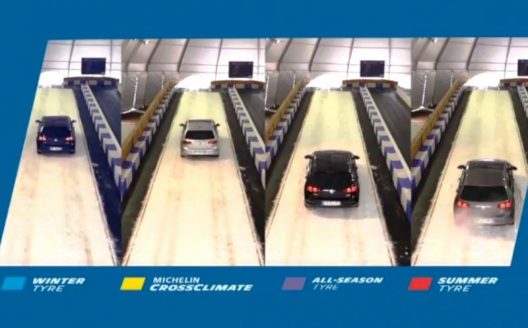Differences between summer, winter and all-season tires

What changes between the “authentic” winter tires from those simply marked M + S ? Is it true that four-season tires are cheaper all year round in summer and winter? After seeing how the Michelin tires are made and the real road driving tests conducted for the development of the latest Michelin Pilot Sport4 and Michelin CrossClimate, we will reveal you with the help of Patrizio di Blasi , an expert on Michelin Standards and Regulations, as recognize summer, winter, four-season and hybrid tires and in which driving situations are most suitable. What guarantees grip and directionality in driving on snow, ice and asphalt with winter tires? Because a special summer tire like the CrossClimate can be good on the snow, but in summer is it not recommended to drive with traditional winter tires? Find out in this interesting video.
“WINTER FOR RUBBERS BEGINS AT 7 ° C” – Whether it is summer or winter, it makes little difference in the choice of the most suitable tires, what really matters is the ambient temperature that is steadily reached throughout the season and under which conditions asphalt you find yourself driving every day as the grip changes and.
As explained by Patrizio di Blasi in the video above, in fact, it is not the M + S brand that makes winter rubber (since there is not even a regulated test!) let alone a four-season tire to drain the rain of a copious August thunderstorm compared to a summer tire. How to choose then? Michelin experts point out that it is important to make a first distinction between the tires that very often equip the recent SUVs with the M + S (Mud and Snow) marking with the mountain logo with 3 peaks with the snowflake .
If in fact both appear to have a very similar tread, only the real winter tires with the snowflake on the side must pass braking tests and grip on snow, they have silica-based compounds and treads appropriately designed to claw snow or ice (see the different types of tires compared in an acceleration test in the image attached with the summer practically “stopped” on ice). For motorists who live by the sea but enjoy skiing every winter weekend, Michelin has developed summer tires with CrossClimate winter certification that combine the advantages of silica compounds (which limit heating and therefore reduce rolling resistance) and 3D carving more accentuated than a summer tire.
The result is better braking and acceleration compared to normal four seasonsto get stuck on snow and ice in undemanding situations, where instead a winter tire would be more comfortable. But what happens if at the end of the mandatory tire orders I continue to drive until the following winter at temperatures well above the 7 ° C with normal winter tires ? For the Italian Highway Code nothing, but it is likely that at the end of the year you will have completely wasted the fuel savings in search of the pump that makes the best price, and you could find yourself in an emergency situation driving the car as if it had flat tires that wear out even before.
